Pyrador
Canis lupus
Most popular as a companion pet!
Advertisement
Pyrador Scientific Classification
- Kingdom
- Animalia
- Phylum
- Chordata
- Class
- Mammalia
- Order
- Carnivora
- Family
- Canidae
- Genus
- Canis
- Scientific Name
- Canis lupus
Read our Complete Guide to Classification of Animals.
Pyrador Conservation Status
Pyrador Facts
- Fun Fact
- Most popular as a companion pet!
- Temperament
- Loyal, protective, affectionate, alert, intelligent
- Diet
- Omnivore
Pyrador as a Pet:
- General Health
- Energy Level
- Shedability
- Trainability
- Intelligence
- Tendency to Chew
- Size
- Family and kid friendliness
- Yappiness / Barking
- Moderate
- Separation Anxiety
- Low
- Preferred Temperature
- Cold climate
- Exercise Needs
- Moderate
- Friendly With Other Dogs
- Group
- Pure bred cost to own
- $500-1,000
- Dog group
- Working
- Male weight
- 55-100 lbs
- Female weight
- 55-100 lbs
This post may contain affiliate links to our partners like Chewy, Amazon, and others. Purchasing through these helps us further the A-Z Animals mission to educate about the world's species.
View all of the Pyrador images!
The Pyrador makes a great guard dog or watchdog as it has a deep bark to alert owners of strangers that is intimidating but not aggressive or violent.
The Pyrador, also called the Labranees, Lapyrenees, or Pyrelab, is a hybrid dog breed that is a cross between the Great Pyrenees and a Labrador Retriever. It is a large-size thick-coated dog with colors of black, yellow, white, or chocolate, a large, deep chest, and a powerful body. Today, the Pyrador is a popular working breed as well as a companion pet.
See all of our expert product reviews.

3 Pros and Cons of Owning Pyradors
| Pros! | Cons! |
|---|---|
| Love their family. These dogs are happiest when they get to spend time and participate in activities with their family. They enjoy children, other dogs, and other pets. | Tendency to chew. They can and will chew up anything that’s not an indestructible dog toy. Satisfy their chewing urges with large dog treats and toys. |
| Low separation anxiety. You can leave this dog at home for several hours at a time, or even days if they are taken care of. They do not tend to become destructive or anxious when left alone. | They shed. This is not a breed for people who are allergic to dogs. They will shed regularly, and most often during the seasonal changing of their coats. |
| Average barkers. This hybrid dog combines the higher, nocturnal barking tendency of the protective Great Pyrenees with the lower barking tendency of the Labrador Retriever. As a result, they probably won’t bark much, except to alert you of strange noises or presences. | Can be large. They can range from medium to large in size, depending on the parent they favor. As a result, their average weight is not going to tend to satisfy most apartments’ rules for allowing dogs. They need to live in a house, although they do not need a yard for their exercise needs. |

The Pyrador has low separation anxiety and does not become destructive when left alone.
©Lora Taylor/Shutterstock.com
4 Different Types of Pyradors
Due to being a hybrid dog and able to favor the traits of either parent or both parents, Pyrador’s possible coat colors are yellow, chocolate, and black like the Labrador Retriever parent, or white or off-white with badger, grey, tan, or reddish-brown markings like the Great Pyrenees parent.
Evolution and Origins
The Pyrador breed is a few decades old and was likely introduced during the 1990s when designer, or hybrid, dogs became popular.
Its parent breed the Labrador Retriever is a sporting breed that dates back to the 19th century, originating in Newfoundland, where it was used as a working dog by fishermen.
Health and Entertainment for your Pyrador
See all of our expert product reviews.
The Great Pyrenees, its other parent breed, is a working breed that goes back to the early 1600s when it was used for sheepherding in the Pyrenees mountains between France and Spain.
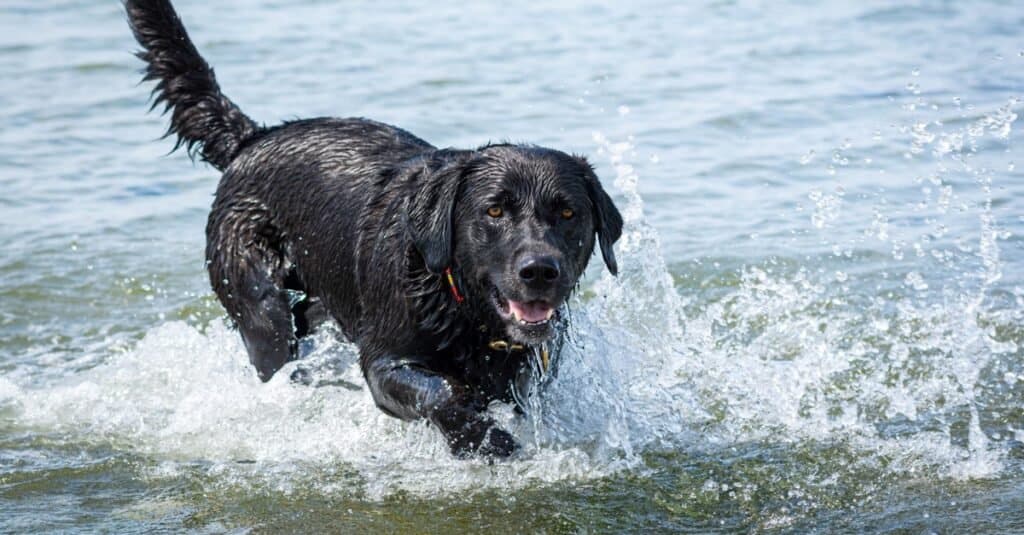
The Pyrador’s parent breed the Labrador Retriever was originally used by fishermen as a working dog.
©Dan_Manila/Shutterstock.com
Size and Weight
The Pyrador is a large-size, double-coat, and medium to long hair dog with a weight range of 55-100 lbs for both males and females and a height range of 21.5-32 inches for both males and females, fully grown. Due to being a hybrid dog breed, the Pyrador has features from both parents but overall tends to favor the build of one parent, and many do not reach the full height and weight of the Great Pyrenees parent. Hence, its weight can range anywhere from 55-75 lbs, 70-90 lbs, or 75-100 lbs due to the Labrador Retriever being medium-sized and the Great Pyrenees large or even giant-sized. Males tend to be larger than females in both weight and height. Pyrador puppies weigh about 12.5 lbs at 8 weeks of age and are typically fully grown between 18-24 months.
| Height (Male) | 23-28″ tall |
| Height (Female) | 21.5-27″ tall |
| Weight (Male) | 70-100 lbs, fully grown |
| Weight (Female) | 55-100 lbs, fully grown |
Common Health Issues
The Pyrador is a hybrid dog that combines the best traits of both the Great Pyrenees and the Labrador Retriever, so it is a very hardy breed. On the other hand, it may have inherited health issues from both parents, such as hip and elbow dysplasia, or bloat (gastric torsion), and digestive issues, which occur more often in deep-chested dogs. Great Pyrenees are also prone to cancers such as osteosarcoma (a type of bone cancer) and reproductive cancers. In sum, the most common health issues Pyradors face are:
- Hip and elbow (joint) dysplasia
- Bloat (gastric torsion)
- Digestive issues
- Cancer.
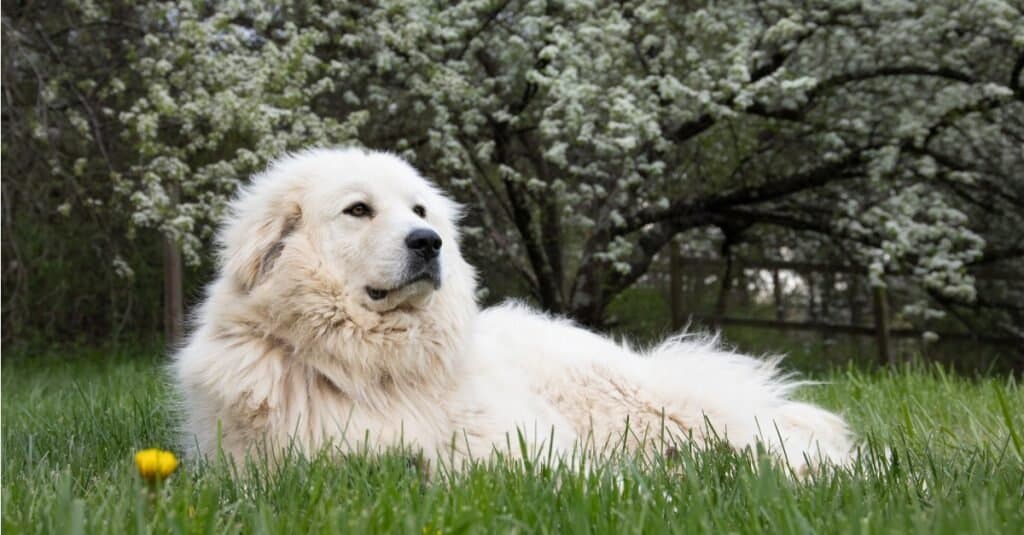
The Pyrador’s parent breed the Great Pyrenees is prone to cancer.
©iStock.com/JZHunt
Temperament
As a hybrid dog breed, Pyradors blend the hunting instincts of the Labrador Retriever with the hunting instincts of the Great Pyrenees. However, they may favor the personality and traits of one parent over the other. Both parent breeds are working breeds, which share similarities in behavior.
The Pyrador is generally known to have a loyal, protective, affectionate, and intelligent personality. Its inherited traits include alertness, an eagerness to please, obedience, and fast learning curve. In its behavior, it may herd family members and other animals, chase smaller animals due to its prey drive, and bark to alert its family of strange faces.
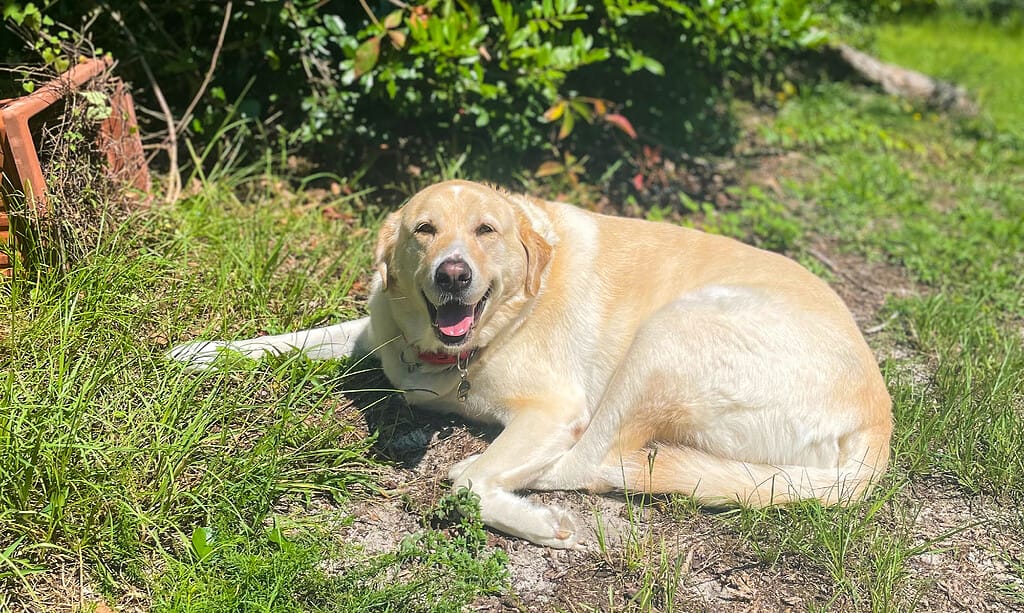
The Pyrador is loyal, protective, affectionate, and intelligent.
©Chelsea Rose Flutter/Shutterstock.com
How to Take Care of Pyradors
New pet owners looking for how to care for Pyradors, especially Pyrador puppies, must consider their age, size, activity level, and health issues. Whether it’s health issues like joint dysplasia or digestive issues, or different care related to their fluffy coat and medium to large size, Pyradors have hybrid-specific factors that must be considered.
The Best Dog Food for Pyradors
Pyradors need a diet that is meant for their size, age, and activity level. Exercise and other activities should be limited after eating to avoid bloat (gastric torsion) and other digestive issues. As a larger, fast-growing dog, it should not be free-fed high-energy (calories) or high-calcium food because it will cause mobility issues, including weight gain and orthopedic diseases. Starchy carbohydrates and grains are addictive and will make them continue eating even after they’re full. Pyradors have a moderate tendency to gain weight.
Pyrador puppy food: Because of their size and hybrid genetics, Pyradors have a tendency to develop hip dysplasia. When considering a wet or dry dog food for large puppies consider a brand that is calcium-rich and contains a variety of other vitamins and minerals, with meat as the primary ingredient. It is best to feed your puppy small meals 2-3 times a day, rationing the daily recommended amount for its age.
Pyrador adult dog food: Similar to puppy dog food considerations, pet owners should consider feeding their adult Pyrador food that is high in calcium with meat as the primary ingredient, and avoid free-feeding. Because Pyradors tend to be high-energy dogs who remain active well into adulthood, we recommend an active dog food variety that is high in calories with no grains that balance carbohydrates with fats and proteins.
Again, choose a dog food suited for your Pyrador’s potential digestive complications that won’t make them pack on the pounds.
At A-Z Animals, we think one of the best options for Pyradors is Blue Buffalo Wilderness Rocky Mountain Recipe High Protein, Natural Adult Large Breed Dry Dog Food.
The high protein formula satiates large and lovable Pyradors’ appetites to curb overeating and bloat. The glucosamine and chondroitin help maintain healthy joints to sustain these big dogs and their activity. There are plenty of amino acids for immune function, with fiber and fermentation extracts so digestion is a breeze.
Check Chewy and Amazon for this product.
- High quality bison is the first ingredient
- Contains no chicken
- Contains antioxidants, peas, and fish meal for Omega 3's
Maintenance and Grooming
Pyrador coats come in black, white, cream, yellow, or chocolate colors. Like both of its parent breeds, the Pyrador has a double coat that is thick and wooly and tends to be long. These dogs need daily brushing with a curry groomer and during shedding season, brushing twice a day. With their long, floppy ears, they need weekly ear cleaning to avoid wax build-up and infection.

Like its Labrador parent breed, the Pyrador has a double coat and sheds regularly.
©iStock.com/Oskari Porkka
Training
Like other dog breeds, the Pyrador can display signs of separation anxiety since puppyhood. It can become depressed and destructive. However, it is simple to socialize and train because it is intelligent and a fast learner. It does best with a combination of vocal praise and rewards of treats. This breed can move easily from basic to advanced training.
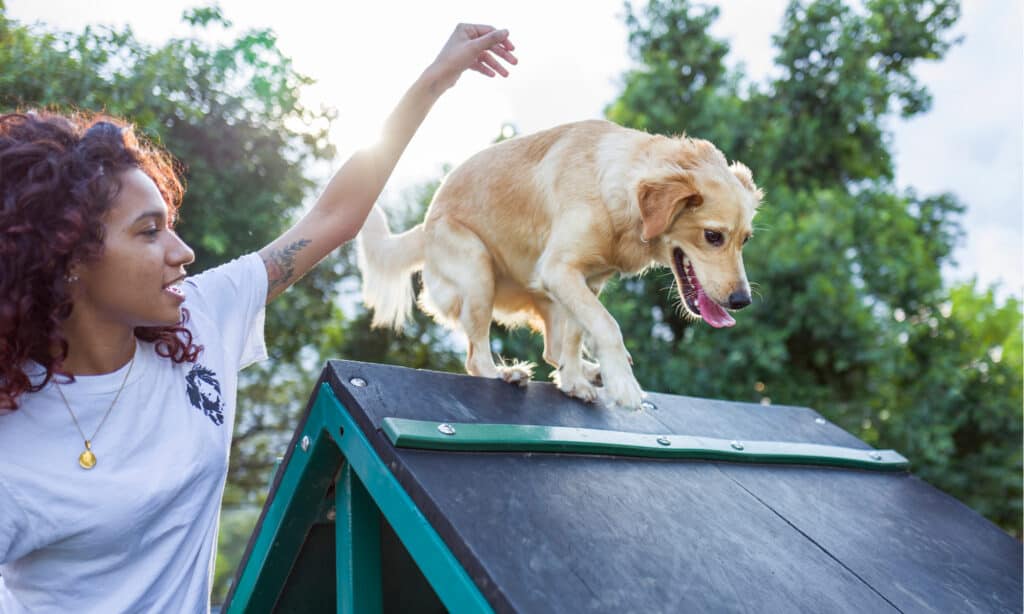
The Pyrador is a fast learner like its Lab parent breed.
©Hernando Sorzano/Shutterstock.com
Exercise
The Pyrador needs both indoor and outdoor activities. It is high-energy, and so needs an hour of exercise every day. Although it doesn’t need to have a backyard, you must be able to take your Pyrador for long walks. It also needs a variety of activities for physical and mental stimulation, such as swimming, fetch, and tug-of-war.

Pyradors, like their Great Pyrenees parents, need at least an hour of exercise daily.
©iStock.com/creativex
Puppies
You can find Pyrador puppies through breeders rather than rescues. Like other dog breeds, exercise should be limited during puppyhood. It is recommended to allow 5 minutes of play for every month of age and to limit activity after feeding.
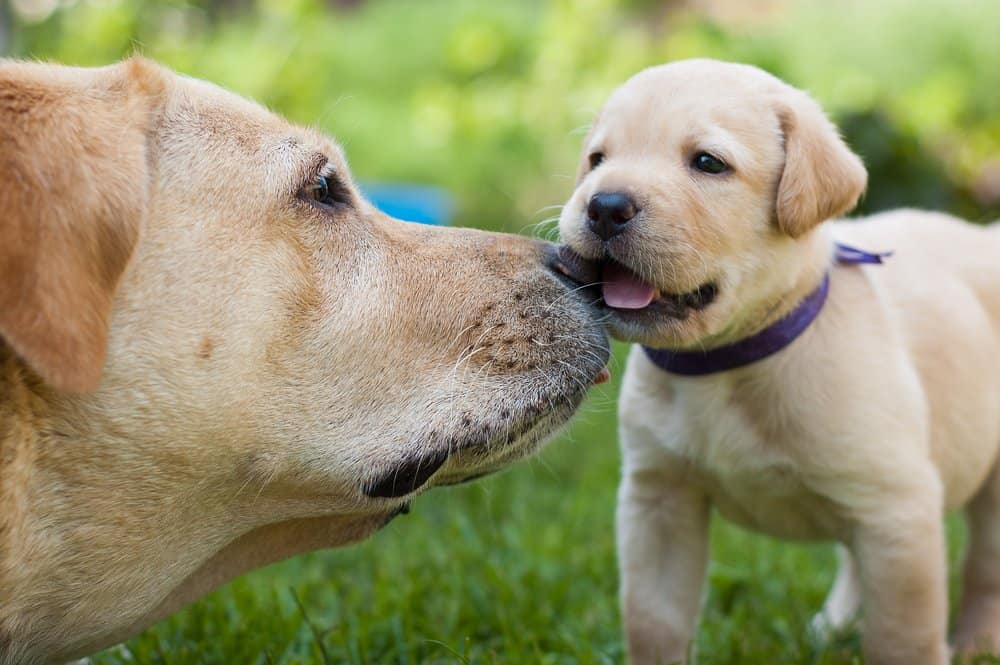
Puppies should have limited activity after feeding.
©Anesssa/Shutterstock.com
Pyradors and Children
Pyradors greatly enjoy and are protective of children. However, they do best with older children since as a large breed, they can knock over small children. For this reason, you must always supervise your Pyrador around small children.
Dogs Similar to Pyradors
Dog breeds similar to Pyradors are of course its parent breeds Great Pyrenees, Labrador Retrievers, and Golden Retrievers. Three others are:
- Newfoundland – A large working, heavy-coated, and well-balanced breed, similar to the Pyrador.
- Kuvasz – A large, white, and flock-guardian breed like the Great Pyrenees parent of the Pyrador. Only keen observation of subtle differences can tell them apart.
- Golden Pyrenees – This hybrid dog breed is a cross between the Golden Retriever and Great Pyrenees. It has a similar build, coat, and temperament to the Pyrador.
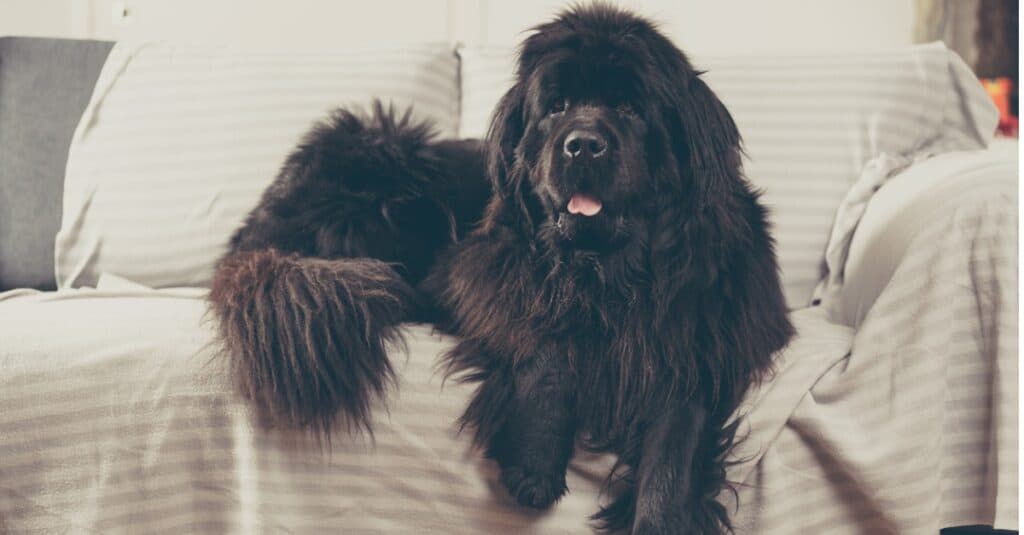
Newfoundlands are similar to Pyradors in their working dog histories.
©iStock.com/rzoze19
Popular Names for Pyradors
Popular names for the Pyrador’s Labrador Retriever parents, which are also the most popular dog names in the United States, are:
- Coco
- Bear
- Shadow
- Leo
- Pepper
- Hunter
- Ranger
- Olive
- Boomer
Pyrador FAQs (Frequently Asked Questions)
What is a Pyrador?
A Pyrador is a hybrid dog that is a cross between the Great Pyrenees, which is also called Pyr or Pyrenean Mountain Dog and an excellent guardian of sheep, and the Labrador Retriever, the easygoing hunting dog and most popular breed in the U.S. for 26 years in a row.
How big will a Pyrador get?
A Pyrador generally tends to be a large (sometimes giant) size breed that can weigh anywhere from 55-100 lbs and have a height of 21.5-28 inches.
Are Pyrador dogs aggressive?
Pyradors do not tend to be aggressive except when acting as guard dogs to protect livestock, family and home. However, if they are badly socialized and untrained they can be aggressive like any other dog. Older dogs from rescues that have been abandoned tend to be family dogs.
Is a Pyrador a good family dog?
Yes, a Pyrador is an excellent family dog.
Do Pyradors shed a lot?
Yes, Pyradors are heavy shedders and need brushing once daily, twice a day if during shedding season.
How much does a Pyrador cost?
A Pyrador can cost anywhere from $500 to 1,000 depending on the breeder. If you get it from a rescue, the cost is the adoption fee.
How long do Pyradors live?
Pyradors typically live 10-12 years.
Thank you for reading! Have some feedback for us? Contact the AZ Animals editorial team.
Sources
- Pet Guide, Available here: https://www.petguide.com/breeds/dog/pyrador/
- Wag Walking, Available here: https://wagwalking.com/breed/pyrador
- Dog-Learn, Available here: https://www.dog-learn.com/dog-breeds/pyrador/
- Dogsnet, Available here: https://dogsnet.com/pyrador/
- Doglime, Available here: https://doglime.com/pyrador/
- The Happy Puppy Site, Available here: https://thehappypuppysite.com/pyrador/
- Dog Breed Info, Available here: https://www.dogbreedinfo.com/p/pyrador.htm
- The Dogman, Available here: https://thedogman.net/pyrador-labrador-retriever-great-pyrenees/
- The Labrador Site, Available here: https://www.thelabradorsite.com/pyrador/
- K9 Web, Available here: https://www.k9web.com/breeds/great-pyrenees-lab-mix/


















